A Simple SEO Guide for eCommerce Sites

Having an eCommerce store appear among the top search engine results is a common aim. But there’s more to eCommerce SEO than just growing your website’s ranking and using keywords to boost organic traffic. Ideally, your online retail store should not only be easy to find but also be scalable, fast, and user-friendly. This, in much, explains why it’s important not to overlook the store’s optimization both technically and SEO-wise.
In this post, we’ll cover some of the eCommerce SEO best practices. We’ll show what to tweak in an online store on the examples of renowned brands. Plus, we’ll go over several site optimization tricks and share some useful tools. Let’s roll!
What to SEO Optimize in eCommerce Stores
So why is SEO important for eCommerce? Just like for any website, reaching good organic traffic and top-notch site performance are the things to strive for. A site should ideally be quick, intuitive for users, and have good content. Then it has better chances for high rankings and a good flow of visitors. Below, we’ll share the ways how to do SEO for eCommerce websites to outperform the competition and make clients happy with their experience.
1) Page Speed
Opening our eCommerce SEO guide is the vital factor of page speed. Without any doubt, site owners should firstly pay attention to how fast the store is. This performance metric influences not just the site’s Google rating. Importantly, speed has a direct impact on:
- site and cart abandonment,
- bounce rates,
- conversion rates,
- user satisfaction,
- and customer retention.
Check out the following statistics by Website Builder Expert. 25% of site visitors abandon a website if it takes more than 4 seconds to load? As little as 4 seconds may sound, this speed is actually considered bad.
Thus, perform an SEO analysis of your eCommerce store. Then think about the ways how you can improve the site’s performance in terms of speed. As, frankly, no matter how awesome the store’s design is or how cool the products are if your site takes ages to load, your users won’t convert as well as you’d expect them to. Users get irritated with slow performance and leave the store empty-handed, especially when shopping from mobile devices. These are prospects and leads you don’t want to lose!
Tips on Boosting eCommerce Site Speed: PWAs
One of the ways to optimize your eCommerce store’s speed is by building a progressive web application. A PWA is a modern solution for boosting a website’s performance, particularly when it comes to mobile devices.
PWAs encompass the best of what native applications have in terms of visual appeal and simplicity of navigation. Furthermore, they work right from the browser and offer flying page opening speeds. If developed properly, progressive web apps can skyrocket user satisfaction and conversions. They can also make Google happy with the store SEO-wise.
To demonstrate, these are screenshots from the Tally Weijl online store. This is what their progressive web application looks like on a mobile screen. The design looks a lot like a downloadable application, agree? Yet it works from the browser and is very fast.
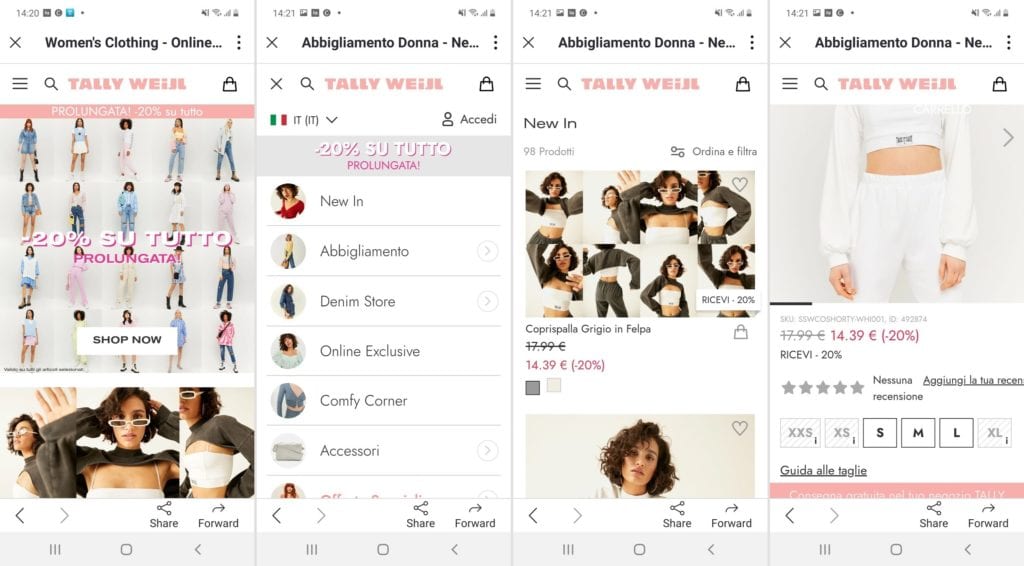
Screenshot taken on the official Tally Weijl website
2) Site Structure & Top Menu
Moving on to the eCommerce SEO checklist, as you audit your store, give your site structure some thought. Plus, you should sensibly choose which links make it to the site’s top navigation menu.
Recommendations on an Online Store’s Hierarchy
You should make sure that you organize your online store’s pages in terms of hierarchy very wisely. When properly categorized and lined out, the site structure becomes easy to “read” for the bots that scan websites. It makes site navigation simpler for your buyers as well.
That said, put all products under the correct categories. In turn, break down the categories logically. This applies to rationally placing all other page types as well. This includes your static pages, blog posts, contact pages, among others. Check that no pages are left uncategorized or out of place.
Tips on Organizing an Online Store’s Top Menu
Pretty much the same thing regards your site’s top menu. As you work on your eCommerce homepage SEO optimization, make certain that the top menu isn’t overloaded with too many pages and tabs. Try to place only the most important product categories and other vital information within the menu.
Small tip: it’s a good sign if a user can reach any of your product pages in only 3 to 4 clicks from the site menu. So, organize your menu levels as simply as possible.
An example I’d like to show you is the top menu of the Hugo Boss website. This eCommerce store has a very broad product range. There are 3 levels of the menu with “MEN / WOMEN” being the first one. 7 subsections in the second-level category and the corresponding product categories and other page types in the third level. In essence, this means that after clicking on a category in the third level, the user is just one click away from the product page, forming 4 clicks in total, and this is good.
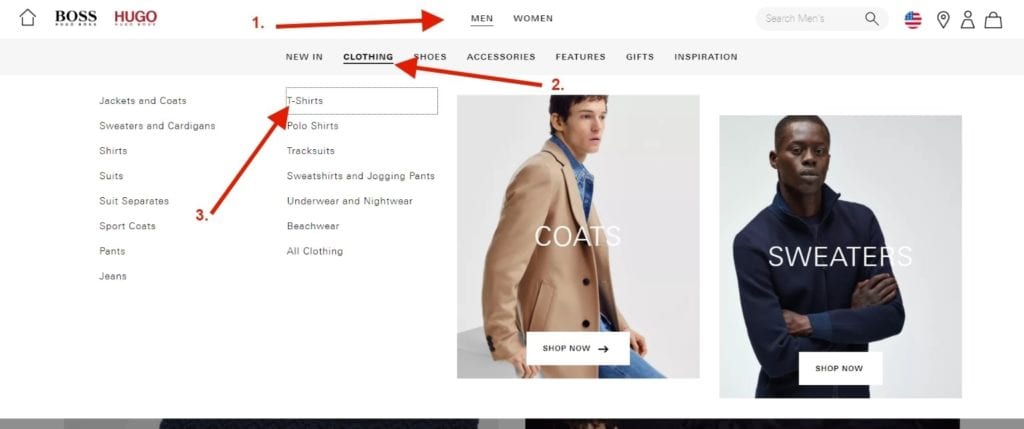
Screenshot taken on the official Hugo Boss website
3) Image Compression & Optimization
Here’s another SEO for eCommerce websites recommendation. Be certain that you’ve compressed and optimized store images.
Recommendations on Compressing eCommerce Store Images
Yes, in order to present a product in the best possible way, you have to have top-quality pictures. A good SEO-friendly site design is no less vital. Usually, there are a plethora of images on an eCommerce site.
But, if your images are large-weight and too heavy, they will greatly slow down the page load times. This is super bad for the online store’s SEO. Plus, it increases bounce rates and can get you to lose your potential customers.
Therefore, to scale down your online retail store’s media without losing quality, you can:
- Link up various caching tools to your website. These depend on the platform you built your store on. For example, you can even get a Content Delivery Network solution.
- Try to compress uploaded pictures manually (for instance, using tools like TinyPNG or Compress JPEG).
- Choose in favor of modern image formats, such as lightweight WebP or JPG.
- Consider opting for lazy-loading and progressive JPEG loading.
- Use the solution of several versions of the picture that’ll be shown based on the receiver’s screen size.
Tips on eCommerce Store Image Optimization
Next, don’t forget to fill out the image alternative texts. They’ll appear in place of a broken image icon on the client’s side in case the picture goes off. Furthermore, this can enhance your chances for search by image. So, add keywords and don’t forget to put in the name of the product and your brand.
Thirdly, name your image properly. Apriori named images in a format that isn’t “IMG-12345” is a great step up for your brand. Name the picture according to the product before uploading it to your site, this is beneficial for SEO too. Furthermore, don’t forget to fill out the image title. This is the text that a user will see when hovering over the picture.
Case in point: this is an image from a product page on the official Givenchy website. As you can see, the image format is JPG. The “Alt” text reads “GIVENCHY coat in leather View-1, Display in full screen”. If the picture had a corresponding product name in it too, this would have been a three-out-of-three example.
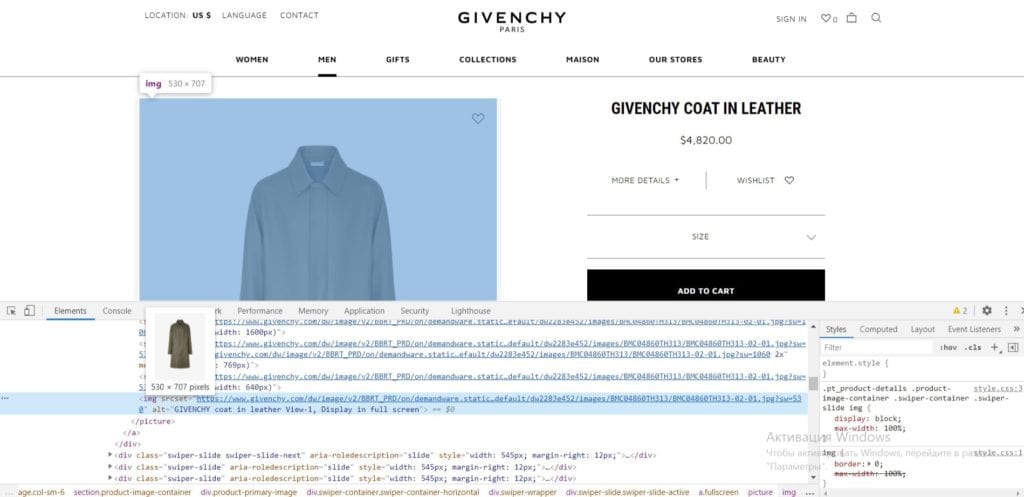
Screenshot taken on the official Givenchy website
4) Proper Naming of Products & Their Descriptions
SEO marketing in eCommerce pays attention to correct product naming too. Product names have to be catchy, or portray the collection, or have a keyword.
Yes, finding the right names isn’t simple, the same thing occurs when crafting product descriptions. But in simple SEO terms, have your keywords present in the needed places. This way, you’ll already be one step closer to success.
When working on your SEO for eCommerce product pages, give extra attention to your H1 title, subheadings, other texts. Ideally, they should have keywords.
Below is a screenshot from the Adidas website. This product page uses the product name as the H1 and H5 headings. It also uses two keywords within the description area. These are “responsive running shoes” and “Adidas running shoes”. Did you notice that the breadcrumb section (Home → Running → Shoes) is as little as three steps?
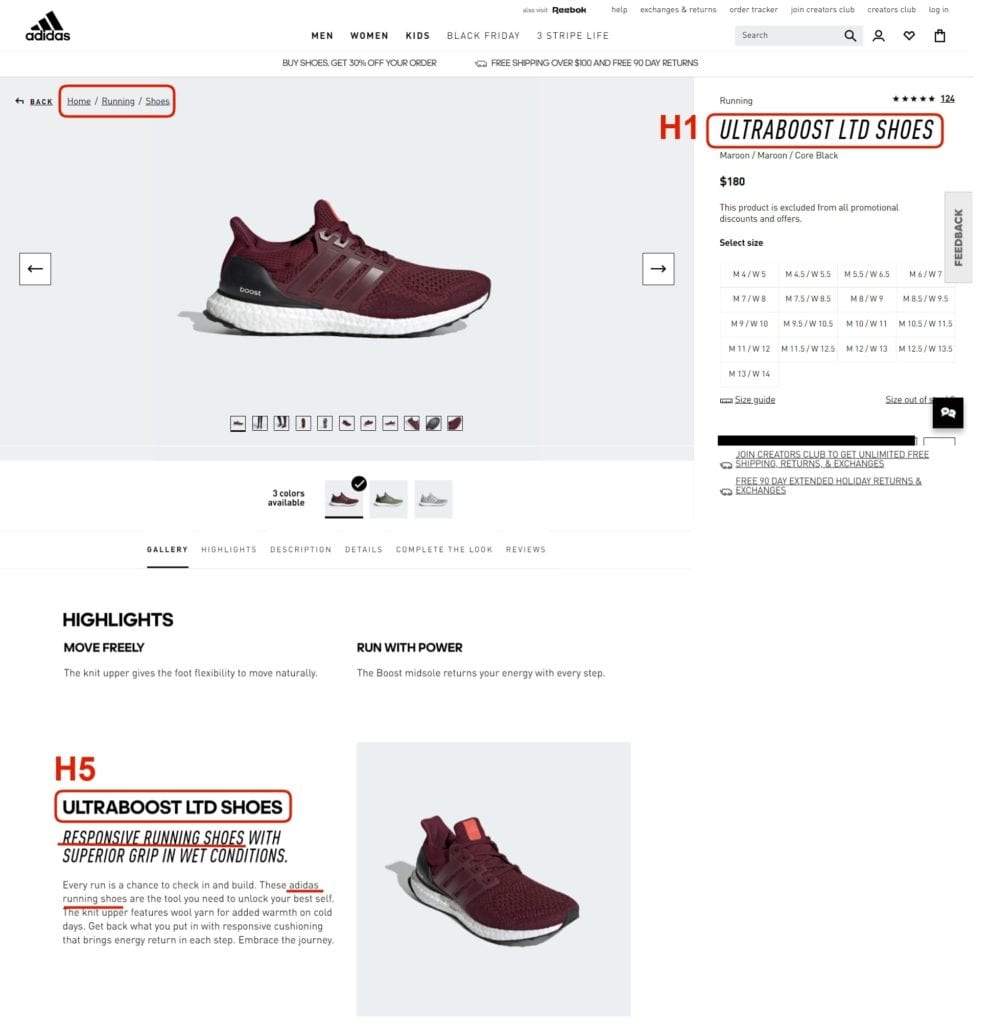
Screenshot taken on the official Adidas website
5) Keyword Usage in eCommerce SEO Done Right
The standard keyword choice can vary and needs to be researched. You should take the required time to find out which specific words or phrases users tend to choose when they search for a product.
Pull out the needed keywords with the biggest search volumes and the most suitable ones best-describing your products. Do what you can to move away from generic and hard to rank for keywords. Instead, choose more specific long-tail ones. Then place them naturally on your pages.
A few things to note here. There’s a rising hype around voice assistants like Alexa or Siri. People use them to make their lives simpler. So, you should also mind voice search peculiarities when thinking about the SEO optimization of your eCommerce store. Unlike short and to-the-point phrases that people type in, voice requests are usually longer. Thus, to have your store cover such requests, you should implement various “oral speech” phrasing too.
More SEO Optimization Tips for Online Retail Stores
Furthermore, there are a couple more things to be on the lookout for in terms of keywords. As you work on your eCommerce SEO optimization, mind the following:
- To begin, let’s mention some of the main eCommerce SEO tools for SEO site analysis. These are good for conducting your store’s keyword research. You can use the popular Ahrefs and Semrush (both come on a paid basis) or the free Ubersuggest tool. Choose your keywords wisely!
- The second one regards overdoing it with keywords. Stuffing one too many keywords on a page is bad and leads to negative results. Your keywords shouldn’t be obvious, do your best to place them naturally. And don’t use the same keyword over and over again many times either.
Thirdly, the same keywords shouldn’t repeat on multiple different pages. This can cause the pages to compete with each other and cannibalize each other’s traffic. This is a big SEO mistake.
To give you an example, let’s turn back a bit to the product naming topic. Take a look at this Calvin Klein category page. As you can see, three products have the exact same title “Monogram Logo Slub Polo Shirt”. These are three separate product pages with different URLs. Therefore, such a naming choice is definitely not the best. These pages will most likely compete!
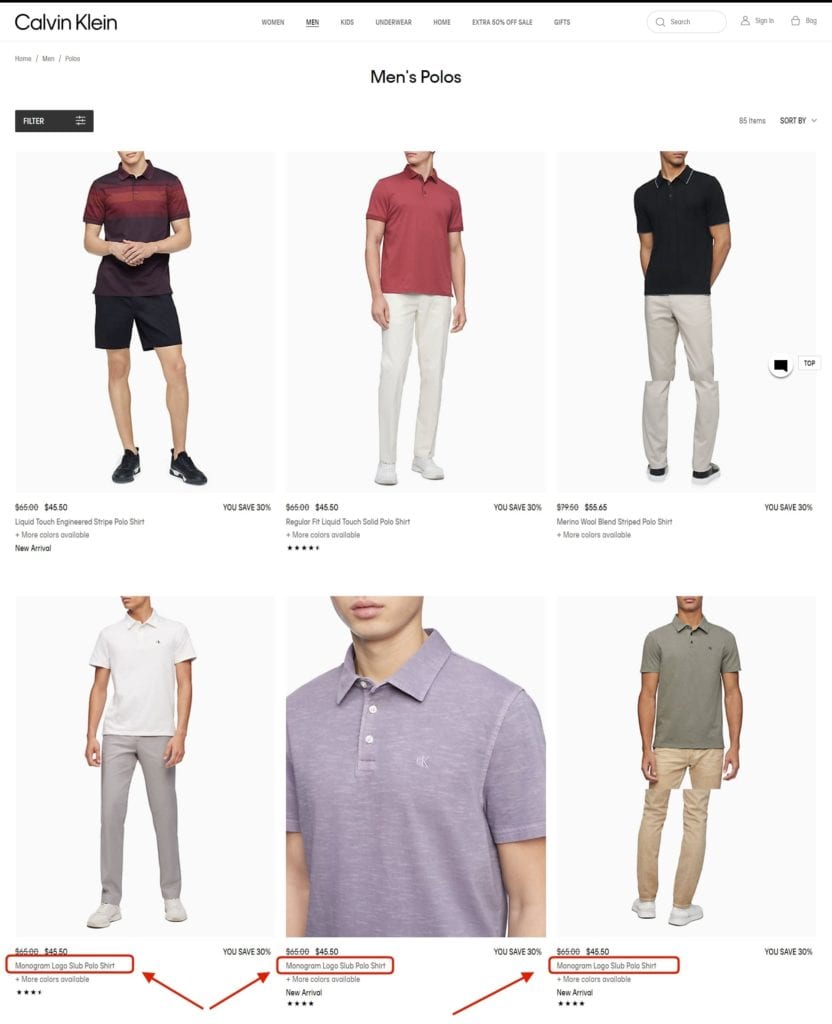
Screenshot taken on the official Calvin Klein website
6) URL & Meta Information
A couple of words about your URLs and meta information. Automatically-generated URLs aren’t always a good solution. Why? They can be super long, irrelevant, not feature your keywords.
Think your URLs through. Take advantage of the opportunity to add a relevant keyword with the product name, for instance.
You’ll need to think about getting backlinks too. So, as a marketer in eCommerce, you should have a strong link-building strategy. Not to mention that you must create content that people would like to share and link to. For this reason, for simplifying content sharing, you can, for example, add social media buttons to your pages.
Lastly, don’t forget to fill out the good old “meta”. Give your page titles, descriptions, and other details the needed time. Avoid copy-paste and choose the phrasing smartly. It’ll help the search engine match your pages with specific user requests.
Final Thoughts
Making an online store outperform competitors and customers happy is a hard task. SEO optimization requires a lot of effort, attentiveness, constant analysis, and change. At times even some minor tweaks can already give the store a big leap in terms of client satisfaction. It can positively influence organic growth in the SERPs too. Hopefully, you’ve found the SEO for eCommerce tips covered in the article handy!

